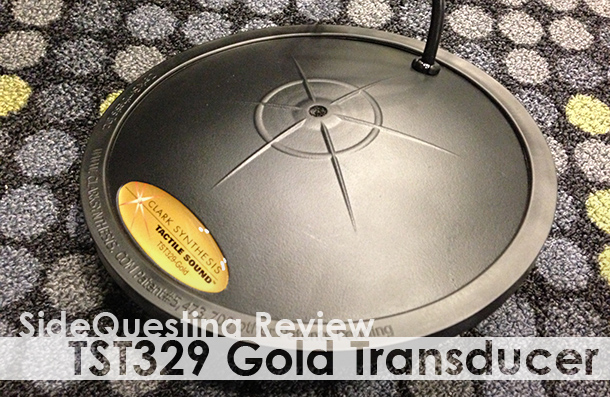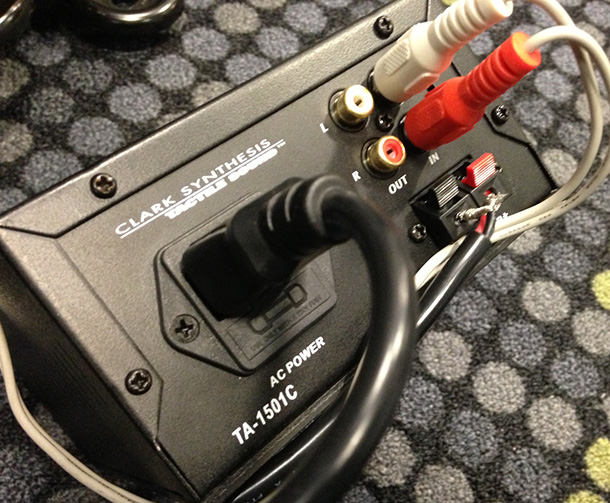
I’m not a huge audiophile, although after all of the tech reviews I’ve been doing of late I certainly might be turning into one. I’ve certainly become more interested in and critical of the sounds that I’ve been hearing coming out of games, and how to better experience their intended effect. Headphones and speakers are fairly straightforward to compare in that respect; a good headset will bring great, full audio to me while emphasizing privacy, and a good speaker will get me closer to being surrounded fully by sound.
I’ve come to have a fairly good idea of what to look for and expect in these devices, and how they can improve or hinder my experience. I know what makes my ears happy.
Then I tried the TST329 Gold Transducer, and everything changed. Not only were my ears hearing the sounds, but my entire body was feeling them.
Clark Synthesis bills itself as a leader in tactile sound technology. Tactile sound is, in layman’s terms, the “ability to feel the vibrations” of an audio source. This can be as simple as the vibration of bass coming from the subwoofer in the trunk of your 1998 Pontiac Grand Prix, or the full on feeling of boom and bounce you might find in a megaplex THX theater coupled with a D-Box motion seat rumbling as Duane Johnson chases after Vin Diesel in a Camaro. What Clark Synthesis does is somewhere in the middle, providing sound waves you can “feel” to consumer and industry clients for a variety of applications.
The TST329 Gold Transducer is one of their latest products, ushering in their new era of gaming audio equipment along with the TST239 Silver. The transducers are disc-like devices that attach to the bottom or back of a seat, projecting forward bursts of sound waves in tune to the music. The magic that Clark Synthesis has bottled inside of these mini-UFOs is pretty incredible, at least based on my month with the TST329 Gold.

The transducers are heavy-duty audio devices, and that needs to be remembered when applying them to our needs. They go well beyond the slight rattle that we get from a typical sound-based gaming chair, and therefore need to be handled and mounted with a slight bit of know-how. These aren’t for the casual gamer, but for someone who’s willing to go the extra distance and have a dedicated gaming set up in their home.
Clark recommends the transducers be mounted horizontally or vertically for the best results. When we first tested the TST329, we mounted it to the bottom of an office chair. Attachment is easy, requiring only that we mount a supplied bolt to the bottom of our seat (we needed to drill into the seat, though) and screwing on the disc. The parts are heavy, but not more than you’d expect. The disc sits just a couple inches off of the surface, seeming to hover in parallel to our butts. The transducer uses speaker cords, which are plugged into an amplifier (sold separately) that sends the audio its way. The Clark Synthesis amp that was provided to us had RCA L/R audio inputs and outputs (for additional speakers) and the power adapter. That’s essentially it for connections, and took all of about 5 minutes to put together.

We were ready to go.
For our first audio test, we plugged in our Xbox 360 and played through a few races of Forza 4. As we ripped around courses, the transducer would send the audio waves and vibrations up through the seat, mimicking which sides of the road were running into grass, or when a car passed us. The rumble was solid, but even more so when we revved up the engines of different vehicles. I could “feel” the brakes as the engine rumbled. The audio seemed to separate itself a little, as if each track of the sound was sent individually and reacted differently. It was slightly jarring, but definitely enhanced the experience.
Things turned for the nearly insane when I took a jaunt through Call of Duty: Black Ops 2. Explosions in the distance were felt with slight rumbles on the outside of the perimeter of my seat, bullets zipped past my right side, a tank slowly rumbled on my left. My entire body shook when a grenade went off nearby. I felt as though my environment was coming alive with the sounds of war, and enjoyed every bit of it.
[pullquote_left]I could feel each individual instrument in the music[/pullquote_left]
Other games didn’t fare quite as well. The Walking Dead doesn’t have enough variety in the audio to really showcase the effects of the transducer, and Monaco didn’t seem to have the body-jarring design to do it either. Action, racing (and possibly even sports) games seem to work best, as anything with shifting, changing, multiple layers of audio made my bones rattle in pleasant, exciting ways.
Plugging in Rock Band 3, DJ Hero 2, and later my iPod yielded some incredible results. I swear that I could feel each individual instrument in the music, with the flop flop flop of EDM overlaid with drums and cymbals coming in exceptionally well. With the music games, I was a rock star; I was in the concert, performing to a huge crowd. Every note reverberated up through my body, and yet it didn’t even need to be very loud to do so. The experience was enough to send some of my co-workers at my office into a frenzy once I piped some Dubstep or classic rock. “Ooooh! Oh my!” was a common response when people first sat in the seat. “You can feel him plucking each string!” Satriani and Deadmau5 never sounded (or felt) so good.

We mounted the TST329 vertically to the back of a racing seat at one point, to see what would happen. The effect was just as powerful, with the sound now shooting through us and out of our chests the louder and harder we pushed it. Even for its weight, it stayed in place just fine. Perhaps that’s the only complaint I have with the device: it’s not the prettiest thing. It’s large — which is why mounting it to the bottom of a seat is recommended — and it has a thick cord that comes off of one end. If I sat in front of a computer to game, then placing it on the non-visible bottom wouldn’t really be an eyesore. It can be mounted under a sofa or even under tiles or floorboards, though I shift around a lot when I play games and prefer a dedicated seat to attach this to.
But again, it’s designed more for the individual who wants to get that extra special experience out of their entertainment. I can imagine that the ultra-serious gamer might mount it to their favorite chair and throw a custom box around it, or build a nice enclosure out of wood or metal. It’s made to be experienced, not seen, after all.
I have to admit that the TST329 surprises me. I wasn’t expecting “tactile audio” to be as engrossing as it is, especially not from a simple device like this. Though the 329 is near military-grade, the slightly lower-end 239 should more than satisfy even the most dedicated gamers who want that augmented experience to spill out of the televisions and into their rooms. It’s a nicely enhanced, very welcome way to enjoy games, and one that I look forward to trying with every game I have just to feel the results. For its $400 MSRP (a quick Amazon search shows much lower prices) the TST329 is a fantastic device, and one that anyone who wants to enhance their entertainment experience should try out.
This review is based on a version of the product sent to SideQuesting for review. The same reviewed device was later purchased by SideQuesting because Dali enjoyed it so much.



2 Comments